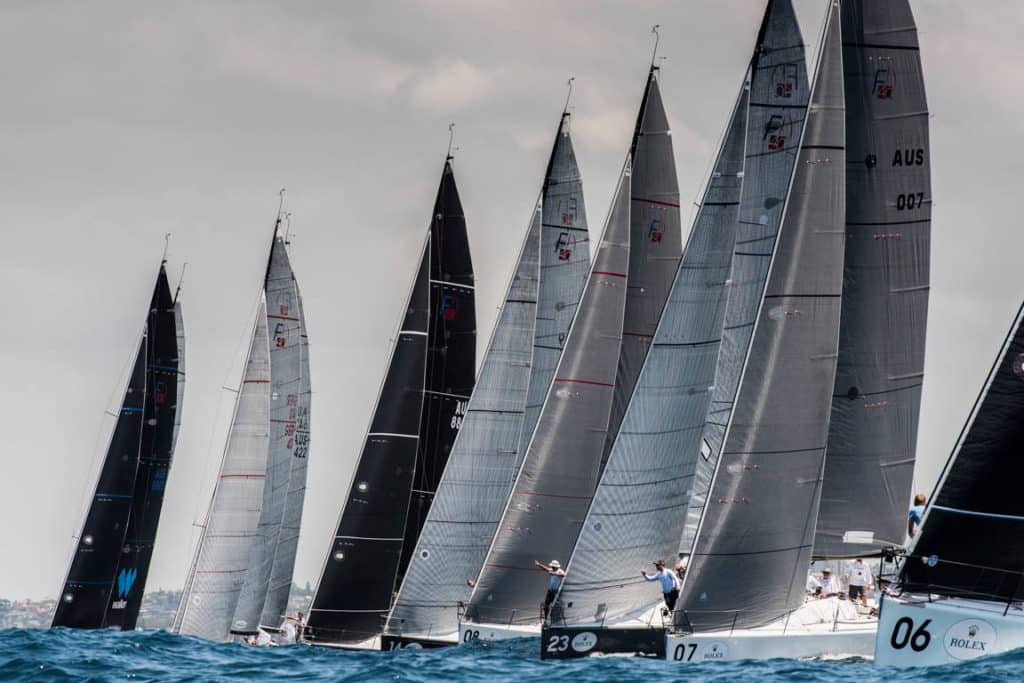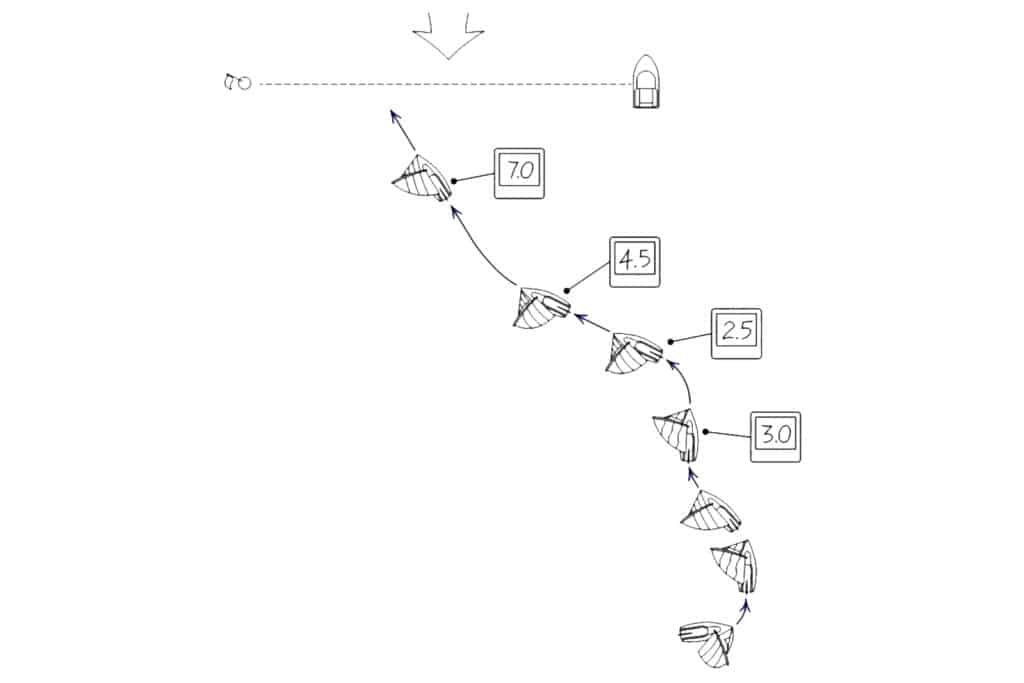
I was sailing a Farr 40 at Key West Race Week in the late 1990s and we were having a difficult time accelerating off the starting line. We couldn’t quite hit the correct angle when we headed down, our timing was off coming up to the line, and we were having trouble coordinating that with the necessary sail trim. It all meant we weren’t completely up to speed when we needed to be, so we started working on an acceleration drill that I’ve been using with teams ever since. Without exception, it has improved acceleration time and resulted in better starts.
Enhance your pre-race routine by taking about five minutes to run through the following drill three to four times. Doing so will tell you what you need to do to get up to speed in the existing conditions. The first time you run the drill, it will typically take you between 50 and 90 seconds to get up to speed. The second time, it will take typically 60 percent less time than the first, and with a couple of more runs, some even get down to 30 percent of the first trial.
How beneficial is the drill? Think of it this way. The actual start will be most of the fleet’s first acceleration of the day, meaning it will take them between 50 and 90 seconds to get up to speed, but because you ran through a few acceleration drills, you can be up to speed 40 percent faster than the other boats. This translates to anywhere from a half knot to a knot advantage at the gun—and when the fleet is lined up bow-to-bow, that’s tremendous.
The Drill
There are three parts to getting it right. Set up head-to-wind with a little forward momentum, just as you would for a real start. Then, bear away on starboard tack to a course well below closehauled to build speed. Next, continue on that course for 5 to 10 seconds to quickly build speed. Finally, gradually turn up to a closehauled course while continuing to build momentum so that when you hit the line you’ll be at top speed and the correct upwind angle (see diagram).
Begin by going off to one side of the starting line, sailing on starboard tack, and then luffing head to wind. You can make it a little more realistic by beginning on port tack, tacking over to starboard tack, and then going head to wind—as you would in a normal port-tack approach. Once head-to-wind, watch your speedometer and monitor the rate at which your boatspeed decreases. When racing, your goal is to always keep the boat moving forward. This is particularly important on boats with small appendages, which tend to slide a lot once you lose flow around the blades. Stay above 4 knots so the boat has some grip; when you drop below that the boat just starts sliding. For the drill, I’ll typically use a boatspeed number that’s one knot less than the lowest speed we would want to be at during a perfect approach. If the number is 4 knots, then I’ll try to practice beginning at 3 knots, which makes the drill more difficult than actual racing starts.

While head-to-wind, and when the speed is right, I’ll tell the crew, “When I say go, we’re going to accelerate.” I’ll count down, “3-2-1-go” so that they’ll be starting the turn down at “go”. Then I start my stopwatch and observe. I’ll stop my watch when we hit our target boatspeed and tell the crew how long it took to accelerate. We’ll do three or four of these in a row, depending on how well we do with them, making sure to run the drill the same way each time.
Perfecting the acceleration requires all hands to be aware and on top of their positions so everyone’s in sync through the turns, especially the trimmers and the helmsman. Crewmembers not trimming sails will be part of this as well because crew weight movement can dramatically influence the turns and minimize rudder movement, especially in lighter winds and with more weight-sensitive boats.
Let’s break the drill down, starting with the helmsman. The first part of the drill is all about quickly getting to your optimum acceleration angle, the second is about building speed without giving up too much height, and the third is a gradual carve up to a close-hauled course without overshooting your target speed or getting too high.
Get through the first part as quickly as possible. When you begin to bear off, you’ll be at 40 to 50 percent of your boatspeed. Suppose your upwind target boatspeed is 7 knots. If you bear away from luffing at 3 knots and stop at the correct angle to begin building speed, you’ll end up at around 2.5 knots. You don’t want to be at this speed for too long, so the angle you sail to get the speed back up to 4 to 5 knots isn’t critical. If you have to bear away another 10 degrees to get there quicker then do so. Experiment to see what angle gets you there sooner. Once you’re at the correct angle at this moment of the drill, keep the rudder straight. You’re never going to accelerate if you’re dragging a lot of rudder through the water. Plus, if the rudder’s straight, it’s producing lift and working. Use sail adjustments to make that happen. Once you’ve built to about 60 percent of the target boatspeed start paying attention to the angle.
The third part, the turn-up, requires you to make the turn really smooth while building speed. If you’re doing it correctly, which means you’ll be using sail trim and crew positioning to turn the boat, you’ll use very little rudder movement.
Here’s where the sail trimmers really come into play. From a luffing position, you might need to back the jib to get the boat to bear away, especially in choppy conditions. Do the drill the same way each time. If you back the jib once, do so every time. Once you’ve started the turn down, over trim the jib a little extra to force the bow to leeward, helping the boat get onto a deeper course. Set up the sails for a reach. For the mainsail, that means keeping the vang taut so you’re not giving up power by twisting off the leech as the mainsheet gets eased. In light winds have someone hold the clew down, which is like moving the car forward for close reaching, keeping the jib leech straighter (let the inhauler off, if you have one).
Once you get to the optimum speed-build angle and you’re into the second part of the drill, the main should start coming in, with the jib following it to match their profiles. Bringing the main in ahead of the jib will help the boat turn up. Coupled with a shift in crewweight, the turn down should stop, and the boat will land on its optimum acceleration angle. The moment you hit the correct angle, trim the sails so that the boat sails straight with maximum power.
Once your speed is on target, the mainsheet/jib sheet trimmer combination should slowly start to turn the boat up for the final part of the drill. The first part of the turn up will be quick, and then the turn rate will decrease as you get to your closehauled course. The turn up is probably about 20 seconds and covers about 15 degrees. You don’t want the jib eased and luffing or you’ll turn up too quick and be sacrificing power. The speedo will have 5- to 7-second delay, so on the final part of the acceleration, if you find that your speed overshoots the target, it’s probably because you’re not accounting for that delay. Overall, the goal is to finish the drill as quickly as possible, give up as little room to leeward as possible, and end at your target upwind speed.
Crew positioning is key. Getting used to where you’re actually going to stand, whether you’re the one on the mainsheet, grinding a winch, or simply hiking. The most complicated element is steering the boat with the crew weight. If it’s moderate or light air, or kind of bumpy, crew should be positioned so that boat always has a little extra heel. This is especially true when head to wind in choppy conditions—if the boat is flat, it will stop. In flat water, or moderate air, keep the boat flatter.
Once the helmsman hits the lowest angle he’ll be at for the acceleration and moves into the second part of the drill, the crew heels the boat to leeward to slow the turn down. Rather than using the rudder to stop the bear-away turn, the crew weight forces the boat to stabilize at that angle. You’ll be heeled as you are when sailing upwind.
Have someone calling the move: “Leeward in 3, 2, 1, go.” That way, when the helmsman hits the optimal acceleration angle, let’s say it’s 50 degrees, the heel prevents the boat from bearing away any further. You also don’t want the boat to head up, so flatten the boat once it’s on the acceleration component of the drill. You’ll know the boat is flat enough when the rudder is straight and the sails perfectly trimmed.
For the final part of the drill—the slow turn up to your closehauled course—shift the crew weight again so you have 3 to 5 degrees of extra heel, which will help the boat turn up in those remaining 20 seconds. When you hit closehauled and you’re up to speed, everyone can shift to full hiking.
Putting The Drill Into Action
At the start, you’ll likely end up in one of two situations. The first is where there is a hole to leeward where you can run through a full acceleration drill, just as you practiced it and come up onto the line at the right angle and full speed. The other is where there is not quite enough room for that, such as when there is another boat a length or two to leeward. If that’s the case, put the bow down deep, do a normal acceleration like you would without anybody there, and eat up the hole. Even though you’re now closer to the boat to leeward, you’re still going to accelerate more quickly because they didn’t run through a speed-build drill. In about 20 seconds, you’re going to be going so much faster that he’ll never catch you. If he’s doing a similar turn down, chances are that he won’t start until he sees you begin your turn. The distance between you will remain about the same, but you’ll come out ahead because you started the build before he did. Either way, you’re ahead of the game—and the competition.









